Your Child's First Fever
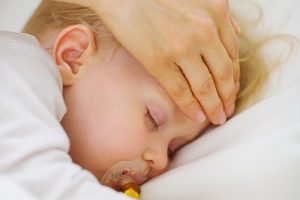
There is nothing more distressing than when our babies have high fevers. The first fever that reaches 41 degrees is a complicated situation to face. It floods our mind with uncertainty and concerns, leaving little room for anything else.
When this occurs it becomes a priority to run in search of medical attention. Emotional support is also important to help us respond effectively to the situation and prevent catastrophic results.
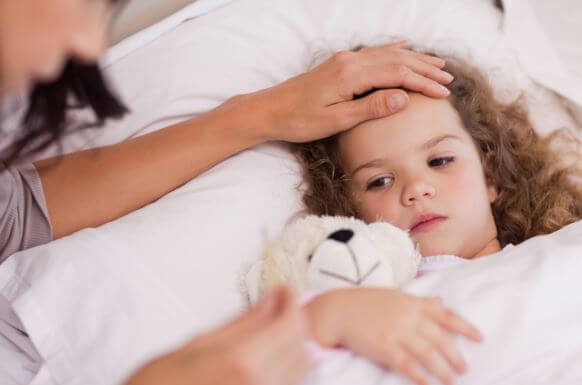
The anguish caused by the first high fever is inevitable
It’s natural and perfectly understandable for a parent to tense up emotionally and physically when confronted with these stressful situations. Without knowing how or why, we run in search of assistance such as medical explanations on how to reduce the little one’s fever.
Both older children and babies often begin to show symptoms of a fever starting with strange behavior. Their little eyes might begin to redden and look fatigued which makes us suspect that something is wrong.
Being aware of these signals is very important since a baby can’t talk or tell us how they feel. Even a sick child that is a little older who is suffering from a fever may not be able to explain to us much more than the fact that they don’t feel well.
That’s why it’s so important for us to always pay close attention. We need to give their fevers the attention they deserve. Below are some guidelines on how to deal with your little one’s first high fever.
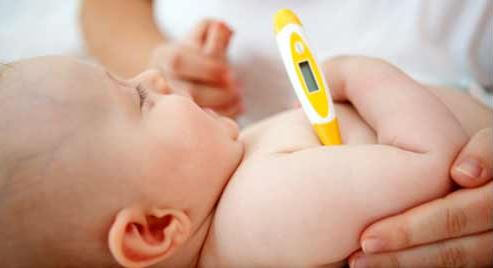
How to act when your child has a fever
First of all, we should know that something is not right in their little bodies when they have a high fever or slightly high temperature.
However, we shouldn’t pay too much attention to whether the fever is high or low, because there are infections such as bronchiolitis that occur with lower temperatures, while tonsillitis occurs with higher ones.
Our sixth sense as mothers help us. It enables us to recognize whether our child is grumpier, more fatigued or apathetic than usual. It’s also important for us to measure their temperature with a working thermometer.
Now, the question is, how do we know if a child has a fever depending on their temperature? Pediatricians have established some general guidelines for classifying a fever based on axillar (armpit) temperature:
- Up to 37.5ºC is a low-grade fever. In principle it isn’t a big cause for concern if the child is over three months old.
- Between 38ºC and 39ºC is classified as a moderate fever. If your child manifests this temperature you should consult their pediatrician without hesitation in order to find and treat the source of the fever.
- Higher than 39ºC is known as a high fever and requires immediate medical attention.
If you decide to take your child’s temperature orally or rectally, you should know that the temperatures in both of those locations are higher than the axillar temperature. Therefore, it is important to know the differences that exists between all three locations.
If you’re using an infrared thermometer you must follow the manufacturer’s instructions carefully. In the case of traditional thermometers, the conversion of temperatures depending on the location is like this:
Rectal Temperature 0.5ºC> Oral temperature 0.5º> Axillary Temperature.
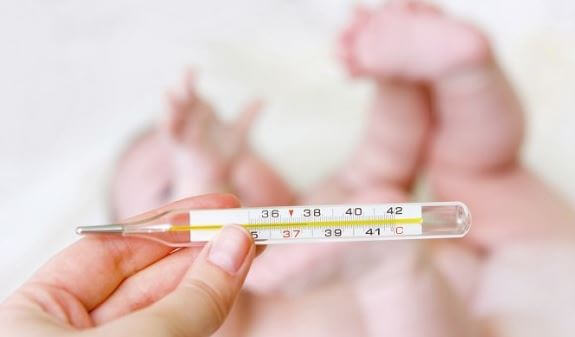
Fever in babies less than 3 months old
In the case of newborns and babies less than 3 months old, fever must be handled in a different way. We must be cautious and sometimes interpret it in different ways.
We must take into account their clothes, the vaccines they have received, or if they’ve been in someone’s arms. We must consider these precautions because babies still don’t properly regulate their body temperature.
If after normalizing the baby’s situation the fever doesn’t go below 37.5ºC, you should see your doctor. They will determine the cause of the fever and treatment if necessary.
After the age of three months, children already start to develop their own immune system and therefore they should be evaluated in the margins that we discussed previously.
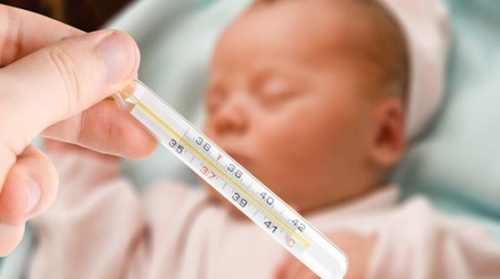
What can we do to reduce fevers?
If the temperature is not very high (37.5ºC) we should start by removing some clothes. We should also give them water and offer them warm food.
Don’t hug them or carry them too much at this point. This will help the child regulate their own body temperature.
If the fever is 38ºC you can give them a warm water bath that is two degrees lower than their body temperature. If this isn’t possible, moisten the nape of their neck, chest and groin with a sponge with warm water.
It’s also appropriate at this point to give them an antipyretic that your pediatrician advises for moments like this. When giving medication you should always respect your pediatrician’s indications.
If the fever persists despite all of these actions, you should consult your doctor without hesitation.
During a child’s first year of life, fever will be their faithful companion. Therefore, it is important for us to familiarize ourselves with it and know how to act in every situation.
There is nothing more distressing than when our babies have high fevers. The first fever that reaches 41 degrees is a complicated situation to face. It floods our mind with uncertainty and concerns, leaving little room for anything else.
When this occurs it becomes a priority to run in search of medical attention. Emotional support is also important to help us respond effectively to the situation and prevent catastrophic results.

The anguish caused by the first high fever is inevitable
It’s natural and perfectly understandable for a parent to tense up emotionally and physically when confronted with these stressful situations. Without knowing how or why, we run in search of assistance such as medical explanations on how to reduce the little one’s fever.
Both older children and babies often begin to show symptoms of a fever starting with strange behavior. Their little eyes might begin to redden and look fatigued which makes us suspect that something is wrong.
Being aware of these signals is very important since a baby can’t talk or tell us how they feel. Even a sick child that is a little older who is suffering from a fever may not be able to explain to us much more than the fact that they don’t feel well.
That’s why it’s so important for us to always pay close attention. We need to give their fevers the attention they deserve. Below are some guidelines on how to deal with your little one’s first high fever.

How to act when your child has a fever
First of all, we should know that something is not right in their little bodies when they have a high fever or slightly high temperature.
However, we shouldn’t pay too much attention to whether the fever is high or low, because there are infections such as bronchiolitis that occur with lower temperatures, while tonsillitis occurs with higher ones.
Our sixth sense as mothers help us. It enables us to recognize whether our child is grumpier, more fatigued or apathetic than usual. It’s also important for us to measure their temperature with a working thermometer.
Now, the question is, how do we know if a child has a fever depending on their temperature? Pediatricians have established some general guidelines for classifying a fever based on axillar (armpit) temperature:
- Up to 37.5ºC is a low-grade fever. In principle it isn’t a big cause for concern if the child is over three months old.
- Between 38ºC and 39ºC is classified as a moderate fever. If your child manifests this temperature you should consult their pediatrician without hesitation in order to find and treat the source of the fever.
- Higher than 39ºC is known as a high fever and requires immediate medical attention.
If you decide to take your child’s temperature orally or rectally, you should know that the temperatures in both of those locations are higher than the axillar temperature. Therefore, it is important to know the differences that exists between all three locations.
If you’re using an infrared thermometer you must follow the manufacturer’s instructions carefully. In the case of traditional thermometers, the conversion of temperatures depending on the location is like this:
Rectal Temperature 0.5ºC> Oral temperature 0.5º> Axillary Temperature.

Fever in babies less than 3 months old
In the case of newborns and babies less than 3 months old, fever must be handled in a different way. We must be cautious and sometimes interpret it in different ways.
We must take into account their clothes, the vaccines they have received, or if they’ve been in someone’s arms. We must consider these precautions because babies still don’t properly regulate their body temperature.
If after normalizing the baby’s situation the fever doesn’t go below 37.5ºC, you should see your doctor. They will determine the cause of the fever and treatment if necessary.
After the age of three months, children already start to develop their own immune system and therefore they should be evaluated in the margins that we discussed previously.

What can we do to reduce fevers?
If the temperature is not very high (37.5ºC) we should start by removing some clothes. We should also give them water and offer them warm food.
Don’t hug them or carry them too much at this point. This will help the child regulate their own body temperature.
If the fever is 38ºC you can give them a warm water bath that is two degrees lower than their body temperature. If this isn’t possible, moisten the nape of their neck, chest and groin with a sponge with warm water.
It’s also appropriate at this point to give them an antipyretic that your pediatrician advises for moments like this. When giving medication you should always respect your pediatrician’s indications.
If the fever persists despite all of these actions, you should consult your doctor without hesitation.
During a child’s first year of life, fever will be their faithful companion. Therefore, it is important for us to familiarize ourselves with it and know how to act in every situation.
All cited sources were thoroughly reviewed by our team to ensure their quality, reliability, currency, and validity. The bibliography of this article was considered reliable and of academic or scientific accuracy.
- de Liria, R; Méndez Hernández, M. Fiebre sin foco. Protocolos diagnóstico-terapéuticos de la AEP: Infectología pediátrica. 37- 45. [Documento en línea].
- Gómez Ayala A-E. La fiebre en la edad pediátrica. Pautas de actuación. Offarm. 2008;27(1):53-57.
- González Requejo Á, Saavedra Lozano J. Niño febril: fiebre sin foco, fiebre prolongada, fiebre en el niño viajero. Tratamiento antitérmico. En: AEPap ed. Curso de Actualización Pediatría 2008. Madrid: Exlibris Ediciones; 2008. p. 347-59.
This text is provided for informational purposes only and does not replace consultation with a professional. If in doubt, consult your specialist.








